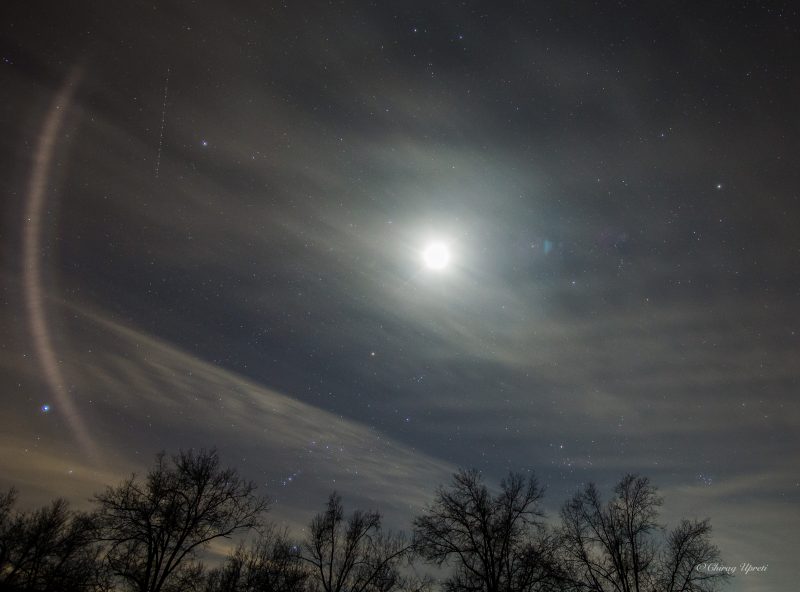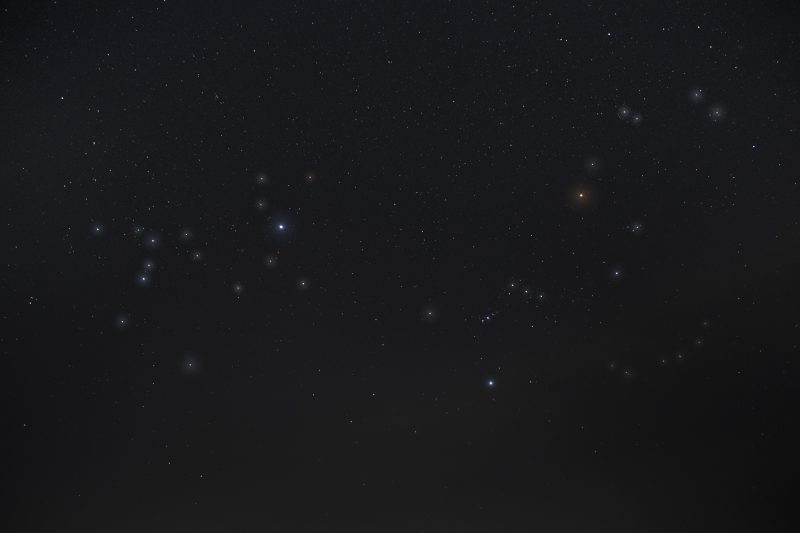
For the next few evenings – April 19 to 21, 2018 – look for the moon and Winter Circle (or Winter Hexagon) stars. It’s difficult to convey the humongous size of the Circle, a great lasso of brilliant stars that fills our western sky at dusk and nightfall.
Look for a circular (or hexagonal) pattern of bright stars around the moon these next few nights. Just be sure to look at dusk and nightfall, because the Winter Circle stars will sink below the horizon by early evening.
And if you’re out there looking soon after sunset, you might also see a very bright planet. In fact, it’s the brightest planet, Venus, shown at the bottom right on the chart above. The moon has moved up past Venus over the past several evenings. Watch for it!

Chirag Upreti was in Harriman State Park, New York when he caught this shot of the moon and Winter Circle (or Winter Hexagon) on April 2, 2017. He wrote: “The crescent moon illuminated ~42% seen inside the asterism of the Winter Hexagon. Rigel is low and seen between the tree line on the horizon. The passing clouds and the lens flare on the gave a sci-fi feel to the picture at first glance.”

Gowrishankar Lakshminarayanan on Long Island, New York also caught the April 2, 2017 moon inside this great circle (or hexagon) of stars.
The Winter Circle can be seen from around the world, although its orientation with respect to the horizon will be different, depending on where you are.
No matter what part of Earth you’re standing on, though, this same pattern of bright stars will surround the moon around April 19 to 21.
If you’re in the Southern Hemisphere, notice the sky’s brightest star – Sirius – will appear at the top of the Circle and the star Capella at the bottom (if you can see Capella at all; it’s far to the north on the sky’s dome).

The orientation of stars with respect to the horizon – and their height above the horizon – is different as seen from different parts of the globe. Here’s a gorgeous shot from March 30, 2017 of Orion and Canis Major – containing the sky’s brightest star Sirius – as captured from the Philippines on March 30, 2017. Photo by Gabriel Obusan.
The Winter Circle stars are bright, but the brightest starlike object in the sky on these April 2018 evenings is the planet Venus. Venus sits quite low in the west at dusk and sets at or near nightfall.
Enjoying EarthSky so far? Sign up for our free daily newsletter today!
Bottom line: Use the moon on April 19 to 21, 2018, to find the bright stars of the Winter Circle!
from EarthSky https://ift.tt/1ql1xBW

For the next few evenings – April 19 to 21, 2018 – look for the moon and Winter Circle (or Winter Hexagon) stars. It’s difficult to convey the humongous size of the Circle, a great lasso of brilliant stars that fills our western sky at dusk and nightfall.
Look for a circular (or hexagonal) pattern of bright stars around the moon these next few nights. Just be sure to look at dusk and nightfall, because the Winter Circle stars will sink below the horizon by early evening.
And if you’re out there looking soon after sunset, you might also see a very bright planet. In fact, it’s the brightest planet, Venus, shown at the bottom right on the chart above. The moon has moved up past Venus over the past several evenings. Watch for it!

Chirag Upreti was in Harriman State Park, New York when he caught this shot of the moon and Winter Circle (or Winter Hexagon) on April 2, 2017. He wrote: “The crescent moon illuminated ~42% seen inside the asterism of the Winter Hexagon. Rigel is low and seen between the tree line on the horizon. The passing clouds and the lens flare on the gave a sci-fi feel to the picture at first glance.”

Gowrishankar Lakshminarayanan on Long Island, New York also caught the April 2, 2017 moon inside this great circle (or hexagon) of stars.
The Winter Circle can be seen from around the world, although its orientation with respect to the horizon will be different, depending on where you are.
No matter what part of Earth you’re standing on, though, this same pattern of bright stars will surround the moon around April 19 to 21.
If you’re in the Southern Hemisphere, notice the sky’s brightest star – Sirius – will appear at the top of the Circle and the star Capella at the bottom (if you can see Capella at all; it’s far to the north on the sky’s dome).

The orientation of stars with respect to the horizon – and their height above the horizon – is different as seen from different parts of the globe. Here’s a gorgeous shot from March 30, 2017 of Orion and Canis Major – containing the sky’s brightest star Sirius – as captured from the Philippines on March 30, 2017. Photo by Gabriel Obusan.
The Winter Circle stars are bright, but the brightest starlike object in the sky on these April 2018 evenings is the planet Venus. Venus sits quite low in the west at dusk and sets at or near nightfall.
Enjoying EarthSky so far? Sign up for our free daily newsletter today!
Bottom line: Use the moon on April 19 to 21, 2018, to find the bright stars of the Winter Circle!
from EarthSky https://ift.tt/1ql1xBW

Aucun commentaire:
Enregistrer un commentaire